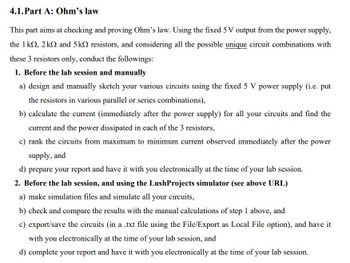
Introductory Circuit Analysis (13th Edition)
13th Edition
ISBN: 9780133923605
Author: Robert L. Boylestad
Publisher: PEARSON
expand_more
expand_more
format_list_bulleted
Question

Transcribed Image Text:4.1.Part A: Ohm's law
This part aims at checking and proving Ohm's law. Using the fixed 5 V output from the power supply,
the 1k, 2k2 and 5k resistors, and considering all the possible unique circuit combinations with
these 3 resistors only, conduct the followings:
1. Before the lab session and manually
a) design and manually sketch your various circuits using the fixed 5 V power supply (i.e. put
the resistors in various parallel or series combinations),
b) calculate the current (immediately after the power supply) for all your circuits and find the
current and the power dissipated in each of the 3 resistors,
c) rank the circuits from maximum to minimum current observed immediately after the power
supply, and
d) prepare your report and have it with you electronically at the time of your lab session.
2. Before the lab session, and using the LushProjects simulator (see above URL)
a) make simulation files and simulate all your circuits,
b) check and compare the results with the manual calculations of step 1 above, and
c) export/save the circuits (in a .txt file using the File/Export as Local File option), and have it
with you electronically at the time of your lab session, and
d) complete your report and have it with you electronically at the time of your lab session.
Expert Solution
This question has been solved!
Explore an expertly crafted, step-by-step solution for a thorough understanding of key concepts.
This is a popular solution
Trending nowThis is a popular solution!
Step by stepSolved in 4 steps with 3 images

Knowledge Booster
Learn more about
Need a deep-dive on the concept behind this application? Look no further. Learn more about this topic, electrical-engineering and related others by exploring similar questions and additional content below.Similar questions
- c) b) Figure. Q2.a below shows two circuits (basic and Widlar current-mirrors) are designed to generate a constant current lo = 10 μA operate from a 10-V supply. Determine the values of R₁, R2, and RE assuming that VBE 0.7V at a current of 1 mA. Vcc= 10V VBE1 Tref R₁ le lot TI le VBE2 lo Figure. Q2.a Basic circuit I, R T2 R1 R₂ Iref Ici Vcc VB61 Consider the circuit shown in Figure Q2.b and show that lo R2 I, R₁ - 1 ~ VT m²/ In Ir-R1 Io -Vcc= 10V VBE21 Τ1 Widlar current-mirror circuit Maar R₂ 9 Figure Q2.b T2 RE - OV 2000 2000-331 What is a noise signal in differential amplifier analysis? Discuss how this signal can be minimized/attenuated.arrow_forwardConsider the circuit in the given figure. Assume R1 = 120 S and R2 = 260 N. R R2 40 V Calculate current i in the given figure when the switch is in position 1. The current when the switch is in position 1 is mA.arrow_forwardHow to do using variation parameter method ?arrow_forward
- 5) a) An AA sized alkaline-manganese battery has a Thévenin voltage of 1.5V and an internal resistance of 0.40. What is the largest current that can be drawn from it if the terminal voltage is not to drop below 1V? b)How much power can the battery in part a deliver to a load of resistance R? What value of resistance R gives the largest power delivered to the load? What is that power?arrow_forwardAssuming that the diodes in the circuits of Figure-3 are ideal, utilize voltage divider theorem to simplify the circuits and thus find the values of the labeled current and voltage. Note: please solve within 30 minutes. Avoid plagiarismarrow_forward
arrow_back_ios
arrow_forward_ios
Recommended textbooks for you
 Introductory Circuit Analysis (13th Edition)Electrical EngineeringISBN:9780133923605Author:Robert L. BoylestadPublisher:PEARSON
Introductory Circuit Analysis (13th Edition)Electrical EngineeringISBN:9780133923605Author:Robert L. BoylestadPublisher:PEARSON Delmar's Standard Textbook Of ElectricityElectrical EngineeringISBN:9781337900348Author:Stephen L. HermanPublisher:Cengage Learning
Delmar's Standard Textbook Of ElectricityElectrical EngineeringISBN:9781337900348Author:Stephen L. HermanPublisher:Cengage Learning Programmable Logic ControllersElectrical EngineeringISBN:9780073373843Author:Frank D. PetruzellaPublisher:McGraw-Hill Education
Programmable Logic ControllersElectrical EngineeringISBN:9780073373843Author:Frank D. PetruzellaPublisher:McGraw-Hill Education Fundamentals of Electric CircuitsElectrical EngineeringISBN:9780078028229Author:Charles K Alexander, Matthew SadikuPublisher:McGraw-Hill Education
Fundamentals of Electric CircuitsElectrical EngineeringISBN:9780078028229Author:Charles K Alexander, Matthew SadikuPublisher:McGraw-Hill Education Electric Circuits. (11th Edition)Electrical EngineeringISBN:9780134746968Author:James W. Nilsson, Susan RiedelPublisher:PEARSON
Electric Circuits. (11th Edition)Electrical EngineeringISBN:9780134746968Author:James W. Nilsson, Susan RiedelPublisher:PEARSON Engineering ElectromagneticsElectrical EngineeringISBN:9780078028151Author:Hayt, William H. (william Hart), Jr, BUCK, John A.Publisher:Mcgraw-hill Education,
Engineering ElectromagneticsElectrical EngineeringISBN:9780078028151Author:Hayt, William H. (william Hart), Jr, BUCK, John A.Publisher:Mcgraw-hill Education,

Introductory Circuit Analysis (13th Edition)
Electrical Engineering
ISBN:9780133923605
Author:Robert L. Boylestad
Publisher:PEARSON

Delmar's Standard Textbook Of Electricity
Electrical Engineering
ISBN:9781337900348
Author:Stephen L. Herman
Publisher:Cengage Learning

Programmable Logic Controllers
Electrical Engineering
ISBN:9780073373843
Author:Frank D. Petruzella
Publisher:McGraw-Hill Education

Fundamentals of Electric Circuits
Electrical Engineering
ISBN:9780078028229
Author:Charles K Alexander, Matthew Sadiku
Publisher:McGraw-Hill Education

Electric Circuits. (11th Edition)
Electrical Engineering
ISBN:9780134746968
Author:James W. Nilsson, Susan Riedel
Publisher:PEARSON

Engineering Electromagnetics
Electrical Engineering
ISBN:9780078028151
Author:Hayt, William H. (william Hart), Jr, BUCK, John A.
Publisher:Mcgraw-hill Education,